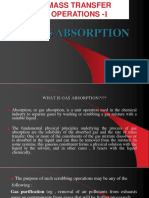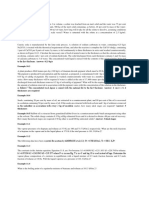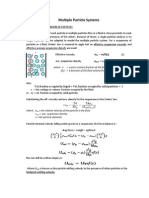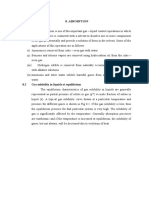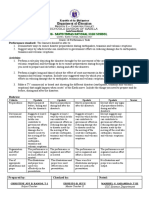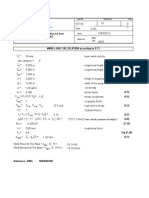Notes Gas Absorption
Uploaded by
Peter Paul BucsitNotes Gas Absorption
Uploaded by
Peter Paul BucsitCHEMICAL ENGINEERING SERIES
GAS
ABSORPTION
Compilation of Lectures and Solved Problems
CHEMICAL ENGINEERING SERIES 2
GAS ABSORPTION
GAS ABSORPTION
A unit operation where a soluble vapor is absorbed from its mixture with an inert gas by means of
a liquid in which the solute is more soluble
Solute is subsequently recovered from liquid by distillation
DESORPTION OR STRIPPING
Process of removing gas dissolved in a liquid and where the liberated gas is taken up in a gas or
vapor in contact with the liquid
It is the reverse of gas absorption
GAS ABSORPTION EQUIPMENT
1. Plate Column
2. Packed Tower
PROBLEMS INVOLVING GAS ABSORPTION:
1.
2.
3.
4.
Calculation of tower height
Calculation of number of equilibrium stages
Calculation of efficiency
Calculation of vapour-liquid handling capacity of the equipment involved
DEFINITIONS OF TERMS:
1. Absorption Column a plate column where gas is absorbed while a gas mixture bubbles
through the liquid which passes down from plate to plate
2. Absorption Factor a parameter in the Kremser equation for calculation of absorption
columns and towers; the product of the total pressure and the liquid flow rate in moles per
second divided by the product of Henrys Law constant and the gas flow rate in moles per
second
3. Absorption Tower a tower where liquid flows down over a packing material in countercurrent or co-current flow with a gaseous mixture while one or more of the gaseous
components are absorbed in the liquid
.
4. Absorbent liquid which takes up one or more components from a gaseous mixture
5. Chanelling the condition in which packing surface is not wetted by the flowing liquid due to
low liquid rates. It is the chief reason for the poor performance of large packed towers.
Channelling is severe in towers filled with stacked packing, which is the main reason they are
not much used. It is less severe in dumped packings.
6. Downcomer a tube or duct leading liquid from one plate in column to the next plate
7. Downflow Flooding in plate columns, excessive build up of liquid on the plates caused by
insufficient drainage through the downcomers
8. Entrainment flooding in distillation and absorption, excessive carry-over of suspended
droplets following the vapour or gas upwards through the column
CHEMICAL ENGINEERING SERIES 3
GAS ABSORPTION
9. Flooding Velocity in a given packed tower with a given type and size of packing and with a
definite flow of liquid, this is the upper limit to the rate of gas flow. At flooding point, the liquid
can no longer flow down through the packing and is blown out with the gas. In an actual
operating tower, the gas velocity is well below flooding. The optimum economic gas velocity
is about one half or so of the flooding velocity
10. Lean Gas outgoing gas mixture in air or gas absorption column/tower
11. Loading Point the point in a logarithmic pressure drop gas velocity diagram for packed
columns where the pressure drop start to increase more rapidly with increasing gas or vapor
velocity caused by rapid increase in liquid hold-up. Further increase in gas or vapor velocity
ends in flooding.
12. Packed Column Tower a column for distillation, absorption or extraction, consisting of a
cylindrical shell filled with small objects (packing) to bring about intimate contact between
rising fluid (vapor, gas, liquid) and descending liquid
13. Packing small objects used to provide a large contact area between rising fluid and
descending liquid in packed columns, such as saddles, rings, grates and pieces of coke
14. Packing Diameter the outer diameter of proprietary rings such as Raschig rings and pall
rings. The size of saddles are given by a number corresponding to one of the dimensions in
inches
15. Random Packing/Dumped Packing in packed columns and towers, packing units lying
randomly as they happened to fall when dumped down
16. Rich Gas gas mixture entering the gas absorption column/tower
17. Scrubbing the process in which a liquid is employed to achieve or assist in the removal of
dispersed particles from the gas
18. Stacked Packing in distillation and absorption columns, a packing consisting of symmetric
materials stacked on top of each other, for instance rings placed beside each other with
vertical axis or wooden grids in cross-packed layers. Wooden grids are used in the aluminum
industry in large towers for absorption of SO2 and hydrogen fluoride from ventilation air
19. Strong Liquor the outlet liquid, which is enriched in solute
20. Weak Liquor the inlet liquid, which may be oure solvent or a dilute solution of solute in the
solvent
PRINCIPLES OF GAS ABSORPTION:
CHEMICAL ENGINEERING SERIES 4
GAS ABSORPTION
Nomenclature:
V'
= molar flow rate of solute-free gas
V 1 = molar flow rate of rich gas
V 2 = molar flow rate of lean gas
L'
= molar flow rate of solute-free liquid
L1 = molar flow rate of strong liquor
y 1 = mole fraction of solute in rich gas
Y 1 = mole ratio of solute with solute-free gas
y 2 = mole fraction of solute in lean gas
Y 2 = mole ratio of solute with solute-free gas
x 1 = mole fraction of solute in strong liquor
X 1 = mole ratio of solute in strong liquor with the solute-free liquor
x 2 = mole fraction of solute in weak liquor
X 2 = mole ratio of solute in weak liquor with the solute-free liquor
Assumptions:
1. Evaporation of solvent is negligible
CHEMICAL ENGINEERING SERIES 5
GAS ABSORPTION
2. The solute-free gas is relatively insoluble in the solvent used. Therefore, solute free gas is
constant
Gas Phase Concentration, based on Daltons Law:
p= yP
y
1 y
Y=
Liquid Phase Concentration,
x=
C
m
X=
x
1 x
Where:
p = partial pressure of the solute in gas
P = total pressure of the gas
C
= moles of solute per unit volume of solution
m = molar density of the solution, moles of solution per unit volume of solution
Over-all Material Balance
V 1+ L2=V 2 + L1
Solute Balance
y 1 V 1 + x 2 L2 = y 2 V 2 + x 1 L 1
Y 1 V ' + X 2 L ' =Y 2 V ' + X 1 L '
L' ( X 1X 2 ) =V ' ( Y 1Y 2 )
L ' Y 1 Y 2
=
V ' X 1 X 2
At any height Z of the absorber,
Y 1 V ' + XL'=YV ' + X 1 L'
CHEMICAL ENGINEERING SERIES 6
GAS ABSORPTION
[ Y V ' =Y 1 V ' + X L' X 1 L' ] V1 '
Y=
L'
L'
X
X +Y OPERATING LINE EQUATION
V'
V' 1 1
Slope , m=
L'
V'
Y intercept =
L '
X +Y
V' 1 1
PERCENTAGE RECOVERY
V ' Y 1V ' Y 2
Recovery =
x 100
V 'Y1
Recovery =
Y 1Y 2
x 100
Y1
X Y PLOT FOR GAS ABSORBER
Note:
Point (1) at the bottom of the absorber
Point (2) at the top of the absorber
SOURCE OF EQUILIBRIUM CURVE:
CHEMICAL ENGINEERING SERIES 7
GAS ABSORPTION
1. Henrys Law for dilute solution
y=
p
P
p=Hx
y=
H
H
x , slope , m=
P
P
Where:
= Henrys Law Constant
2. Raoults Law for ideal solution
p=xP
y=
p
x
P
Where:
= vapor pressure
3. Vaporization Constant
y=Kx
Where:
= vaporization Constant
MINIMUM LIQUID TO GAS RATIO:
CHEMICAL ENGINEERING SERIES 8
GAS ABSORPTION
If
Y 1 ,Y 2 , X 2 ,V '
equilibrium with
are fixed and kept constant,
X1
will corresponds to the value that is in
Y1
If less liquid, L (or more gas, V) is used:
The slope of the operating line will decrease
The exit liquid composition will be greater
The diffusional driving force will be less
The absorption will be more difficult
The time of contact between liquid and gas must be greater
The tower/column must be taller
At minimum liquid rate, Lminimum
The slope of the operating line, L/V, is minimum
The exit liquid composition, X1, will be maximum
The diffusional driving force at point M is zero
The time of contact between liquid and gas in infinite
The height of tower/column is infinite
The minimum liquid-gas ratio represents a limiting value
X 1= X 1 max= X 1
To solve for (L/V)minimum
L'
V'
( )
min
Y 1Y 2
X 1 X 2
ABSORPTION FACTOR:
A=
L'
mG '
When A is large, the solute tends to be absorbed in the liquid phase
GAS ABSORPTION IN PLATE COLUMN
A. Kremser-Brown Absorption Factor use to rapidly determine the number of theoretical
stages for gas absorption. It is based on the assumptions that operating line and equilibrium
diagram are both straight lines
E=
y 1 y 2 AA N+1
=
y 1 y 2 1A N +1
CHEMICAL ENGINEERING SERIES 9
GAS ABSORPTION
ln
N=
AE
A AE
ln A
Where:
= number of theoretical equilibrium stages
= absorption factor
E = effectiveness or percentage absorbed
B. Tiller-Tour Equation simplified Kremser-Brown Absorption equation
ln
N=
ln
N=
AE
A AE
ln A
Y Y 2
L'
1
mV ' Y 1Y 2
L'
L' Y 1 Y 2
mV ' mV ' Y 1Y 2
ln
[ ]
L'
mV '
CHEMICAL ENGINEERING SERIES 10
GAS ABSORPTION
ln
N=
L'
Y 1Y 2 ) m ( Y 1Y 2 )
(
V'
m ( Y 1 Y 2 )
L ' [ ( Y 1Y 2 ) ( Y 1Y 2 ) ]
mV '
( Y 1Y 2 )
ln
N=
L'
Y 1Y 2 )m ( Y 1Y 2 )
(
V'
ln
L'
( Y Y 2 )
V' 2
ln
ln
N=
[
[
ln
[ ]
L'
mV '
Y 1Y 2
Y 1Y 2
Y 1Y 2
( Y Y 2 )
X 1X 2 2
ln
N=
[ ]
L'
mV '
Y 1 Y 2
Y 1 Y 2
( Y 1Y 2 )
( Y 1Y 2 )
X 1 X 2
X 1X 2
Y 1Y 1
ln
Y 2Y 2
[ ]
(
(
] [
] [
=
Y 1Y 2
X 1X 2
Y 1 Y 2
X 1X 2
y 1 y 1
ln
y 2 y 2
ln
)
)
]
]
Y 1Y 2
y 1 y 2
C. Colburn Factor another way to determine the number of theoretical stages for absorbers.
This equation is based on a straight line equilibrium line only. The operating line is not
straight
E=1
A 1 ( A 21 )2
A 2 ( A 11 ) ( A2 N+1 +1 )
CHEMICAL ENGINEERING SERIES 11
GAS ABSORPTION
N=
A1
A2 1 2 1
ln
A2
( 1E ) ( A1 1 ) A 2
Where:
A 1=
ln A2
L1
L
; A 2= 2
mV 1
mV 2
D. McCabe-Thiele Method used if one of the lines (operating line and equilibrium diagram) is
not straight
a. Using mole ratios, (X, Y) operating line is straight line; equilibrium diagram is nonlinear
b. Using mole fraction, (x, y) operating line is non-linear; equilibrium diagram is
straight line
CHEMICAL ENGINEERING SERIES 12
GAS ABSORPTION
GAS ABSORPTION IN PACKED TOWER
Dual Film Theory:
Mass Transfer Equation at the Gas Film
( d N A )G =K G ( P A P Ai ) dA
dA=aS dZ
PA= y A P
CHEMICAL ENGINEERING SERIES 13
GAS ABSORPTION
K G=
Ky
P
( d N A )G =aK y ( y A y Ai ) dZ
Where:
( d N A )G
= rate of mass transfer in gaseous phase = absorption rate
K y = gas phase mass transfer coefficient
a
= packing property (dependent of material type); mass transfer area / volume of
packing material
dA
= mass transfer area
= cross sectional area of the tower
= height of the tower
P A = partial pressure of component A
y A = mole fraction of A in the gas phase
Mass Transfer Equation at the Liquid Film
( d N A ) L =K L ( C AiC A ) dA
( d N A ) L =aK L ( C AiC A ) SdZ
( d N A ) L =aK x ( x Aix A ) SdZ
Where:
(d N A)L
= rate of mass transfer in liquid phase
K L , K x = liquid phase mass transfer coefficient
CA
= concentration of solute in liquid phase
x A = mole fraction of solute in liquid phase
At steady state:
Mass flux in gas = Mass flux in liquid
K y ( y y i ) =K x ( x ix )
K x y y i
=
K y x ix
DESIGN METHODS FOR ABSORPTION OF DILUTE GAS MIXTURES IN PACKED TOWERS
1. Plot the operating line equation.
CHEMICAL ENGINEERING SERIES 14
GAS ABSORPTION
2. Calculate
V=
V ,V 1 , V 2 , L , L1 , L2
V 1 +V 2
L +L
; L= 1 2
2
2
x i1 , y i1 at point
3. Calculate interface compositions,
k 'xa
kxa
slope=
=
ky a
k 'y a
[
[
1
( 1x )
1
( 1 y )
]
]
[ ]
[ ]
1
1x
=
1
k'y a
1 y
k'x a
4. Compute for the tower height
From Geankoplis, equation 6.26, using gas phase
V
( y y )=k ' y a z ( y y i )M
S 1 2
( y y i ) M =
( y 1 y i 1 ) ( y 2 y i 2 )
ln
y 1 y i 1
y 2 y i 2
From Geankoplis, equation 6.27, using liquid phase
L
( x x ) =k ' x a z ( x ix )M
S 1 2
( x ix )M =
( xi 1x 1 )( xi 2x 2 )
ln
x i 1x 1
x i 2x 2
From Geankoplis, equation 6.28, using gas phase
( y y )=K ' y a z ( y y )M
S 1 2
( y y )M =
( y1 y 1 ) ( y 2 y 2 )
y 1 y 1
ln
y 2 y 2
From equation 10.4-24 (Geankoplis)
( 1 y ) M ( 1 y ) m' ( 1x )
=
+
K 'y a
k ' ya
k 'x a
x1 , y1
CHEMICAL ENGINEERING SERIES 15
GAS ABSORPTION
From equation 10.4-25 (Geankoplis)
( 1 y ) M =
( 1 y 1) ( 1 y 1)
1 y 1
ln
1 y 1
From equation 10.4-6 (Geankoplis)
( 1 y ) =
( 1 y i1 ) ( 1 y 1 )
ln
1 y i 1
1 y 1
From equation 10.4-7 (Geankoplis)
( 1x )=
( 1x 1 )( 1x i 1)
ln
1x 1
1x i 1
From Geankoplis, equation 6.29, using liquid phase
( x x ) =K ' x a z ( x x )M
S 1 2
( x x ) M =
( x 1 x 1 )( x2 x 2 )
ln
x 1 x 1
x 2 x 2
You might also like
- 3.04 CH419A Jovellana Humidification FundamentalsNo ratings yet3.04 CH419A Jovellana Humidification Fundamentals46 pages
- Industrial Economics: Dr. Syed Imran AliNo ratings yetIndustrial Economics: Dr. Syed Imran Ali9 pages
- ERT 313 Bioseparation Engineering Gas Absorption: Prepared By: Pn. Hairul Nazirah Abdul HalimNo ratings yetERT 313 Bioseparation Engineering Gas Absorption: Prepared By: Pn. Hairul Nazirah Abdul Halim57 pages
- General Considerations in Plant Design Part100% (1)General Considerations in Plant Design Part29 pages
- Separation Process Engineering CHEN 312: Ys18@aub - Edu.lb100% (1)Separation Process Engineering CHEN 312: Ys18@aub - Edu.lb28 pages
- A Distillation Column With A Partial Reboiler and A Total Condenser Is Being Used To Separate A Mixture of Benzen1No ratings yetA Distillation Column With A Partial Reboiler and A Total Condenser Is Being Used To Separate A Mixture of Benzen13 pages
- Gas Absorption - A Soluble Vapor Is Absorbed From: Liquid Adsorbent Below Its Bubble PointNo ratings yetGas Absorption - A Soluble Vapor Is Absorbed From: Liquid Adsorbent Below Its Bubble Point16 pages
- Chemical Engineering Projects Can Be Divided Into Three Types100% (3)Chemical Engineering Projects Can Be Divided Into Three Types25 pages
- Supercritical Fluid Extraction of Ethanol From Aqueous SolutionsNo ratings yetSupercritical Fluid Extraction of Ethanol From Aqueous Solutions11 pages
- Fundamentals of Chemical Engineering Process Equipment Design100% (1)Fundamentals of Chemical Engineering Process Equipment Design25 pages
- Multicomponent Distillation Shortcut MethodNo ratings yetMulticomponent Distillation Shortcut Method5 pages
- 2 - Dynamic Modelling (Process Dynamics and Control)No ratings yet2 - Dynamic Modelling (Process Dynamics and Control)41 pages
- Modeling of Reactive Distillation Column For The Production of Ethyl AcetateNo ratings yetModeling of Reactive Distillation Column For The Production of Ethyl Acetate5 pages
- Equilibrium Separation Operations: Lecture 1: Introduction100% (1)Equilibrium Separation Operations: Lecture 1: Introduction23 pages
- Overview of Separation Process: Chapter 1 in Henley, Seader & Roper's BookNo ratings yetOverview of Separation Process: Chapter 1 in Henley, Seader & Roper's Book26 pages
- Problem Set - Day 2 Chemical Engineering PrinciplesNo ratings yetProblem Set - Day 2 Chemical Engineering Principles26 pages
- The Problem Was 4 With The Same Assessment of Each Question and Please Answer Correctly in DetailNo ratings yetThe Problem Was 4 With The Same Assessment of Each Question and Please Answer Correctly in Detail1 page
- Liq-Liq & Solid-Liq Separation Notes - 3No ratings yetLiq-Liq & Solid-Liq Separation Notes - 311 pages
- Toxic Release and Dispersion Model May 2017No ratings yetToxic Release and Dispersion Model May 201748 pages
- Bab I Pendahuluan: Tower Yang Dilengkapi Dengan Pemasukan Gas Dan Ruang Didistribusikan PadaNo ratings yetBab I Pendahuluan: Tower Yang Dilengkapi Dengan Pemasukan Gas Dan Ruang Didistribusikan Pada11 pages
- Pressure Drop Vs Air Flow Rate: Flowra Te (L/Min) Pressure Drop (MMH O)No ratings yetPressure Drop Vs Air Flow Rate: Flowra Te (L/Min) Pressure Drop (MMH O)4 pages
- Cambridge Academic Reading Practice Test 44 - WWW - Ieltsdrive.inNo ratings yetCambridge Academic Reading Practice Test 44 - WWW - Ieltsdrive.in10 pages
- Test Bank For Biology How Life Works Second EditionNo ratings yetTest Bank For Biology How Life Works Second Edition58 pages
- A Review On Hydronic Asphalt Pavement For Energy Harvesting100% (1)A Review On Hydronic Asphalt Pavement For Energy Harvesting11 pages
- Condensers: Report By-Ashna Anamika Mugdha PratishthaNo ratings yetCondensers: Report By-Ashna Anamika Mugdha Pratishtha17 pages
- Module 2: Physico-Mechanical Properties of Rocks: Physical Properties Contd... 2.3.1.4 PermeabilityNo ratings yetModule 2: Physico-Mechanical Properties of Rocks: Physical Properties Contd... 2.3.1.4 Permeability8 pages
- The Wild Life of Today and How To Help INFORMATIVE SpeechNo ratings yetThe Wild Life of Today and How To Help INFORMATIVE Speech3 pages
- CDP Conversion of Fuel Data To MWH 2016No ratings yetCDP Conversion of Fuel Data To MWH 201611 pages
- Belton Michael J.S. - Mitigation of Hazardous Impacts Due To Asteroids and CometsNo ratings yetBelton Michael J.S. - Mitigation of Hazardous Impacts Due To Asteroids and Comets435 pages
- International Geological Time Scale Chart1No ratings yetInternational Geological Time Scale Chart11 page
- MCQ Questions With Answers Class 9 Chapter 10 GravitationNo ratings yetMCQ Questions With Answers Class 9 Chapter 10 Gravitation6 pages
- Physical Science Quarter 3 Week 1: Not For SaleNo ratings yetPhysical Science Quarter 3 Week 1: Not For Sale8 pages
- Lesson 1.1. Environment and Basic Concepts of Environmental ScienceNo ratings yetLesson 1.1. Environment and Basic Concepts of Environmental Science3 pages
- The Mathematical Principles of Natural PNo ratings yetThe Mathematical Principles of Natural P439 pages
- 60-2002-Wind Loads Calculations According To EC1No ratings yet60-2002-Wind Loads Calculations According To EC12 pages
- ERT 313 Bioseparation Engineering Gas Absorption: Prepared By: Pn. Hairul Nazirah Abdul HalimERT 313 Bioseparation Engineering Gas Absorption: Prepared By: Pn. Hairul Nazirah Abdul Halim
- Separation Process Engineering CHEN 312: Ys18@aub - Edu.lbSeparation Process Engineering CHEN 312: Ys18@aub - Edu.lb
- A Distillation Column With A Partial Reboiler and A Total Condenser Is Being Used To Separate A Mixture of Benzen1A Distillation Column With A Partial Reboiler and A Total Condenser Is Being Used To Separate A Mixture of Benzen1
- Gas Absorption - A Soluble Vapor Is Absorbed From: Liquid Adsorbent Below Its Bubble PointGas Absorption - A Soluble Vapor Is Absorbed From: Liquid Adsorbent Below Its Bubble Point
- Chemical Engineering Projects Can Be Divided Into Three TypesChemical Engineering Projects Can Be Divided Into Three Types
- Supercritical Fluid Extraction of Ethanol From Aqueous SolutionsSupercritical Fluid Extraction of Ethanol From Aqueous Solutions
- Fundamentals of Chemical Engineering Process Equipment DesignFundamentals of Chemical Engineering Process Equipment Design
- 2 - Dynamic Modelling (Process Dynamics and Control)2 - Dynamic Modelling (Process Dynamics and Control)
- Modeling of Reactive Distillation Column For The Production of Ethyl AcetateModeling of Reactive Distillation Column For The Production of Ethyl Acetate
- Equilibrium Separation Operations: Lecture 1: IntroductionEquilibrium Separation Operations: Lecture 1: Introduction
- Overview of Separation Process: Chapter 1 in Henley, Seader & Roper's BookOverview of Separation Process: Chapter 1 in Henley, Seader & Roper's Book
- Problem Set - Day 2 Chemical Engineering PrinciplesProblem Set - Day 2 Chemical Engineering Principles
- The Problem Was 4 With The Same Assessment of Each Question and Please Answer Correctly in DetailThe Problem Was 4 With The Same Assessment of Each Question and Please Answer Correctly in Detail
- Bab I Pendahuluan: Tower Yang Dilengkapi Dengan Pemasukan Gas Dan Ruang Didistribusikan PadaBab I Pendahuluan: Tower Yang Dilengkapi Dengan Pemasukan Gas Dan Ruang Didistribusikan Pada
- Pressure Drop Vs Air Flow Rate: Flowra Te (L/Min) Pressure Drop (MMH O)Pressure Drop Vs Air Flow Rate: Flowra Te (L/Min) Pressure Drop (MMH O)
- Cambridge Academic Reading Practice Test 44 - WWW - Ieltsdrive.inCambridge Academic Reading Practice Test 44 - WWW - Ieltsdrive.in
- Test Bank For Biology How Life Works Second EditionTest Bank For Biology How Life Works Second Edition
- A Review On Hydronic Asphalt Pavement For Energy HarvestingA Review On Hydronic Asphalt Pavement For Energy Harvesting
- Condensers: Report By-Ashna Anamika Mugdha PratishthaCondensers: Report By-Ashna Anamika Mugdha Pratishtha
- Module 2: Physico-Mechanical Properties of Rocks: Physical Properties Contd... 2.3.1.4 PermeabilityModule 2: Physico-Mechanical Properties of Rocks: Physical Properties Contd... 2.3.1.4 Permeability
- The Wild Life of Today and How To Help INFORMATIVE SpeechThe Wild Life of Today and How To Help INFORMATIVE Speech
- Belton Michael J.S. - Mitigation of Hazardous Impacts Due To Asteroids and CometsBelton Michael J.S. - Mitigation of Hazardous Impacts Due To Asteroids and Comets
- MCQ Questions With Answers Class 9 Chapter 10 GravitationMCQ Questions With Answers Class 9 Chapter 10 Gravitation
- Lesson 1.1. Environment and Basic Concepts of Environmental ScienceLesson 1.1. Environment and Basic Concepts of Environmental Science




























